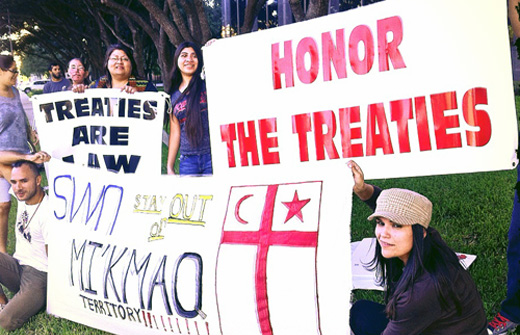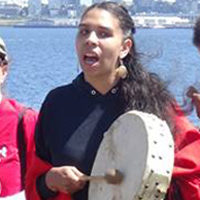
When one thinks about Canada, ideas of socialized health care, marriage equality and maple syrup usually come to mind. However, on October 17, Canada showed its true colors by filing an injunction against the Mi’kmaw Nation blockade in New Brunswick and ordering 200 Royal Canadian Mounted Police (RCMP) to march against the protestors.
The front line of this particular blockade was comprised of the tribe’s elder women. Close behind were the women and children, as well as the male warriors of the Mi’kmaw nation.
While the elders were armed only with drums, feathers, and honor songs, the 200 RCMP that marched against met them heavily armed. They arrived with rubber bullet-filled guns, tear gas, as well as armed snipers to go up against a group of peaceful protesters.
Against these weapons, the Mi’kmaw people began to fight back using only what they had available such as water bottles, rocks and cups of coffee. In videos circulating on the Internet, you can see the Mounties pushing back the crowds as women scream while clutching their faces and men are dragged to ground and kicked. It has also been reported that Mounties showed no discrimination of age when it came to shooting rubber bullets and spraying tear gas at children as well as adults. By the end, Mi’kmaw tribal leadership along with 40 protesters were arrested.
As the Mountie attacks escalated, people of the blockade started setting fire to RCMP vehicles and the tank they brought with them in case a group of peaceful protesters became too much for them to handle. This is the angle that mainstream media is choosing to show, rather than the real issue here: the Canadian government has waged war on the Mi’kmaw people and their land.
Why is Canadian government concerned with the Mi’kmaw land? According to the Department of Energy and Mines of the Province of New Brunswick’s website: In 2010, Canada accepted Houston-based Southwestern Energy Company’s (SWN) bid to begin an exploration program that would cover over 2.5 million acres in order to test new hydrocarbon basins.
But this plan encroaches on the sovereign land of the indigenous peoples, in this particular instance, Mi’kmaw land. This goes against Canada’s own constitution, which states that indigenous people have inherent rights to traditional lands and all of the resources that reside there. LastRealIndians interviewed former Chief of the Elsipogtog Nation, Susan Levi Peter, who said: “According to our understanding we signed an agreement with the New Brunswick provincial government that guaranteed consultation. According to the United Nations Declaration on the Rights of Indigenous Peoples we have a right to free, prior and informed consent with our community before anyone is to drill or pursue something like shale gas, especially by fracking. Additionally, according to the Supreme Court, the provincial government has a duty to consult according to the Marshall case (R. v. Marshall) and the Gray cases (R. v. Gray).”
This has become an extension of the ongoing problem of Canada’s racial profiling of First Nations people. The Canadian government, under the regime of Prime Minister Stephen Harper, seems to think First Nations people incapable of controlling their affairs concerning land, water and other natural resources. The government no longer relies on confusing political jargon in new legislation, now they feel it necessary to use excessive force.
With the introduction of Bill C-45, Harper managed to ignite the Idle No More movement. Bill C-45 is comprised of 400 pages, covering 64 regulations, more than a few of which concern the First Nation people greatly: The bill amends the Fisheries Act, the Canadian Environmental Protection Act, the Navigable Waters Protection Act and the Canada Labour Code. The Mi’kmaw people are one of the few First Nation tribes to assert their sovereignty over their tribal lands.
Since mainstream media seems to have a wrong focus on this issue, many protesters are looking to social media to spread the news and organize actions in solidarity. Outlets such as Twitter, Tumblr and Facebook have been vital in the release of information regarding the Elsipogtog blockade: images of solidarity, videos and reports from the front line. Social media has been key in bringing awareness on this issue.
By donating to the blockades, showing your solidarity, and by simply keeping yourself informed, you can help this movement greatly. The First Nations people and their allies urge you to rise and be IDLE NO MORE!
For sending donations go to http://www.gofundme.com/4uridc This page is to raise money to help support the issues of First Nation people as they continue the fight to keep dangerous fracking off tribal lands.
In a late breaking development reported by CBC News, a request by SWN Resources Canada to extend a court injunction that prevents anyone from impeding its exploration activities in New Brunswick has been denied by a judge. The anti-fracking fight continues.












Comments